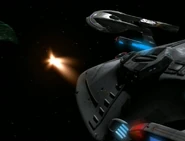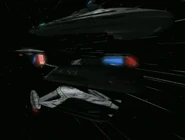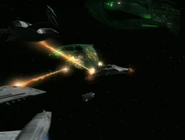mNo edit summary |
m (→Maximum speed: lk fix) |
||
| (3 intermediate revisions by 3 users not shown) | |||
| Line 1: | Line 1: | ||
{{multiple}} |
{{multiple}} |
||
{{Sidebar starship class| |
{{Sidebar starship class| |
||
| − | | |
+ | |name = ''Prometheus'' class |
|image = USS Prometheus, 2374 (fore).jpg |
|image = USS Prometheus, 2374 (fore).jpg |
||
| − | | |
+ | |caption = Forward view |
|owner = {{Federation}} |
|owner = {{Federation}} |
||
|operator = [[Starfleet]] |
|operator = [[Starfleet]] |
||
| − | | |
+ | |active = [[2370s]] |
| − | | |
+ | |crew = 4+ |
| − | | |
+ | |speed = {{anchor|B}}[[warp factor|Warp 9.9+]] <sup>[[#R|↓]]</sup> |
| − | | |
+ | |armament = [[Phaser array]]s, [[photon torpedo launcher]]s |
| − | | |
+ | |defenses = [[Regenerative shielding]], [[ablative hull armor]], [[multi-vector assault mode]] |
|image2 = Prometheus class, aft.jpg |
|image2 = Prometheus class, aft.jpg |
||
| − | | |
+ | |caption2 = Aft view |
|image3 = Prometheus class MSD.jpg |
|image3 = Prometheus class MSD.jpg |
||
| − | | |
+ | |caption3 = ''Prometheus''-class [[Master systems display|MSD]] |
}} |
}} |
||
The '''''Prometheus''-class''' was a highly classified [[Federation]] [[starship]] designed for deep-space tactical assignments. It was one of the most advanced [[Starfleet]] vessels in operation during the later half of the [[24th century]]. |
The '''''Prometheus''-class''' was a highly classified [[Federation]] [[starship]] designed for deep-space tactical assignments. It was one of the most advanced [[Starfleet]] vessels in operation during the later half of the [[24th century]]. |
||
| Line 47: | Line 47: | ||
===Main bridge=== |
===Main bridge=== |
||
[[File:Prometheus class bridge.jpg|thumb|View of the ''Prometheus''-class starship's main bridge]] |
[[File:Prometheus class bridge.jpg|thumb|View of the ''Prometheus''-class starship's main bridge]] |
||
| − | The fact that the ''Prometheus''-class was mainly designed for combat was reflected in the design of its [[bridge]]. The bridge was designed with efficiency in mind, providing the [[commanding officer]] with visual access to all major stations when seated in the command chair. Directly in front of the [[command chair|captain's chair]], sunken down with three steps, was the location of the [[ |
+ | The fact that the ''Prometheus''-class was mainly designed for combat was reflected in the design of its [[bridge]]. The bridge was designed with efficiency in mind, providing the [[commanding officer]] with visual access to all major stations when seated in the command chair. Directly in front of the [[command chair|captain's chair]], sunken down with three steps, was the location of the [[helm]] on the port side and another station to starboard, combined in one large console. The latter was used to activate multi-vector assault mode and assess the status of ship systems, among other tasks. Both officers shared an unobstructed view of the main [[viewscreen]] with the commanding officer. All other stations were mounted against the wall, running around the entire length of the room. Directly [[aft]] of the captain's chair was the [[master systems display]], with ops and tactical stations to starboard and port, respectively. To the captain's left and right, beyond these stations, were doors that may have provided access to the [[turbolift]] system. Further forward still, on either side of the main view screen, were two more stations, which also faced away from the center of the bridge. The starboard one displayed the same graphics as a typical engineering station of the era and provided an alarm when a warp core breach was imminent. Such an accident could quickly be prevented using this station as well. ({{VOY|Message in a Bottle}}) |
===Sickbay=== |
===Sickbay=== |
||
| Line 71: | Line 71: | ||
====Maximum speed==== |
====Maximum speed==== |
||
| − | {{anchor|R}}[[#B|↑]]Dialogue in "Message in a Bottle" suggests that warp 9.9, at which the ''Prometheus'' was traveling, was too fast for any other ship in Starfleet to catch up with before the ship crossed into the neutral zone. This interpretation is confirmed in {{ |
+ | {{anchor|R}}[[#B|↑]]Dialogue in "Message in a Bottle" suggests that warp 9.9, at which the ''Prometheus'' was traveling, was too fast for any other ship in Starfleet to catch up with before the ship crossed into the neutral zone. This interpretation is confirmed in {{STE|?}}. According to ''[[Star Trek: Starship Spotter]]'', however the actual maximum speed of the ''Prometheus''-class was warp 9.99, which corresponds more closely with the idea of the ''Prometheus'' being the fastest ship in the fleet, since the ''Intrepid''-class had been previously established as a ship capable of warp 9.975. |
====Size==== |
====Size==== |
||
| Line 81: | Line 81: | ||
===Apocrypha=== |
===Apocrypha=== |
||
| − | In the |
+ | In the {{DS9 relaunch}} series of novels ''[[Avatar, Book One]]'' and ''[[Avatar, Book Two|Book Two]]'', a ''Prometheus''-class starship named USS ''Cerberus'' served as [[Admiral]] [[William Ross]]' personal [[flagship]], replacing the {{USS|Bellerophon|NCC-74705}}. |
In the game ''[[Star Trek Online]]'', the class is categorized as an "advanced [[escort]]", with sister classes named ''Cerberus'', ''Hephaestus'', and ''Phoenix''. When the class was initially added to the game, it did not feature multi-vector assault mode. This was added at a later date via a "multi-vector assault module" console and also included an alternate ship configuration. |
In the game ''[[Star Trek Online]]'', the class is categorized as an "advanced [[escort]]", with sister classes named ''Cerberus'', ''Hephaestus'', and ''Phoenix''. When the class was initially added to the game, it did not feature multi-vector assault mode. This was added at a later date via a "multi-vector assault module" console and also included an alternate ship configuration. |
||
Revision as of 14:56, 16 February 2020
(covers information from several alternate timelines)
The Prometheus-class was a highly classified Federation starship designed for deep-space tactical assignments. It was one of the most advanced Starfleet vessels in operation during the later half of the 24th century.
History
The class prototype, the USS Prometheus, was launched from the Beta Antares Ship Yards in the Antares sector on stardate 50749.5. At the time of its launch, the Prometheus was so highly classified that only four people in all of Starfleet were trained to operate the prototype. (VOY: "Message in a Bottle")
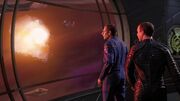
A Prometheus-class starship at the Battle of Procyon V
In an alternate timeline, vessels of the Prometheus-class were among the Federation fleet that engaged the forces of the Sphere-Builders during the Battle of Procyon V in the 26th century. (ENT: "Azati Prime")
Technical data
Propulsion system
The warp drive of the Prometheus-class made the ships of this class faster than any other starship in the fleet at the time in the mid 2370s. The warp drive was capable of maintaining speeds exceeding warp 9.9. (VOY: "Message in a Bottle")
Defensive systems
The Prometheus-class was designed with an unprecedented level of automation, and, combined with its advanced tactical systems, was one of the most powerful combat ships in the Alpha Quadrant. The primary battle systems on board the Prometheus included regenerative shielding, ablative hull armor, phasers, and photon torpedoes.
A unique feature included in the Prometheus design was the multi-vector assault mode, which allowed the ship to split into three semi-independent sections that could each deliver massive force against an enemy target. All three sections were warp-capable. In this mode, the Prometheus could easily disable a Nebula-class at warp, or a D'deridex-class on the field of battle. (VOY: "Message in a Bottle") While other starship classes had similar capabilities, such as the Galaxy-class with its saucer separation feature, generally the saucer section of such classes had no warp drive and limited weaponry. (TNG: "Encounter at Farpoint", "The Arsenal of Freedom", "The Best of Both Worlds, Part II")
Additional systems
In addition to standard automation systems, the Prometheus-class design also featured holoemitters on every deck, which allowed the ship's Emergency Medical Hologram (Mark II) to access all areas of the ship (most EMHs were confined to sickbay only).
Primary controls for the ventilation system were located in Jefferies tube 17, which was located five decks up from sickbay. (VOY: "Message in a Bottle")
Interior design
Main bridge
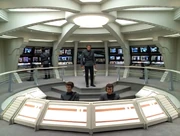
View of the Prometheus-class starship's main bridge
The fact that the Prometheus-class was mainly designed for combat was reflected in the design of its bridge. The bridge was designed with efficiency in mind, providing the commanding officer with visual access to all major stations when seated in the command chair. Directly in front of the captain's chair, sunken down with three steps, was the location of the helm on the port side and another station to starboard, combined in one large console. The latter was used to activate multi-vector assault mode and assess the status of ship systems, among other tasks. Both officers shared an unobstructed view of the main viewscreen with the commanding officer. All other stations were mounted against the wall, running around the entire length of the room. Directly aft of the captain's chair was the master systems display, with ops and tactical stations to starboard and port, respectively. To the captain's left and right, beyond these stations, were doors that may have provided access to the turbolift system. Further forward still, on either side of the main view screen, were two more stations, which also faced away from the center of the bridge. The starboard one displayed the same graphics as a typical engineering station of the era and provided an alarm when a warp core breach was imminent. Such an accident could quickly be prevented using this station as well. (VOY: "Message in a Bottle")
Sickbay
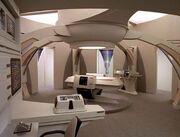
Sickbay aboard a Prometheus-class starship
Sickbays on the Prometheus-class contained a single surgical biobed and a spartan research area. The sickbays were stocked with the latest in medical technologies and were the first to test the EMH Mark II. (VOY: "Message in a Bottle")
Ships commissioned
- Named
- USS Prometheus (NX-59650, prototype)
- Unnamed
Appendices
Appearances
- VOY:
- ENT: "Azati Prime"
Background information
The Prometheus-class was designed by Star Trek: Voyager senior illustrator Rick Sternbach and rendered as a CGI model by Foundation Imaging. The Prometheus-class interiors were designed by Voyager production designer Richard James, using re-dressed portions of the re-created USS Excelsior bridge that James had made for "Flashback", the USS Voyager sickbay, and a number of new sets. One year later, the bridge set went on to again be redressed, for the Nova-class USS Equinox.
Maximum speed
↑Dialogue in "Message in a Bottle" suggests that warp 9.9, at which the Prometheus was traveling, was too fast for any other ship in Starfleet to catch up with before the ship crossed into the neutral zone. This interpretation is confirmed in Star Trek Encyclopedia (? ed., p. ?). According to Star Trek: Starship Spotter, however the actual maximum speed of the Prometheus-class was warp 9.99, which corresponds more closely with the idea of the Prometheus being the fastest ship in the fleet, since the Intrepid-class had been previously established as a ship capable of warp 9.975.
Size
Rick Sternbach notes that the "Prometheus would come in at roughly 1,360 feet (414 meters) in length". (Star Trek: The Magazine Volume 3, Issue 11) A length of 414 meters was also shown on a page from an Eden FX manual. (Star Trek: The Magazine Volume 1, Issue 24)
Additional readings
Apocrypha
In the Deep Space Nine relaunch series series of novels Avatar, Book One and Book Two, a Prometheus-class starship named USS Cerberus served as Admiral William Ross' personal flagship, replacing the USS Bellerophon.
In the game Star Trek Online, the class is categorized as an "advanced escort", with sister classes named Cerberus, Hephaestus, and Phoenix. When the class was initially added to the game, it did not feature multi-vector assault mode. This was added at a later date via a "multi-vector assault module" console and also included an alternate ship configuration.
External links
- Prometheus class at Memory Beta, the wiki for licensed Star Trek works
- Cerberus class at Memory Beta, the wiki for licensed Star Trek works
- Hephaestus class at Memory Beta, the wiki for licensed Star Trek works
- Phoenix class at Memory Beta, the wiki for licensed Star Trek works

